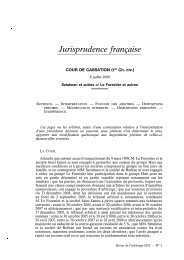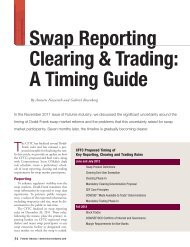What is a Broker-Dealer? - Davis Polk & Wardwell
What is a Broker-Dealer? - Davis Polk & Wardwell
What is a Broker-Dealer? - Davis Polk & Wardwell
You also want an ePaper? Increase the reach of your titles
YUMPU automatically turns print PDFs into web optimized ePapers that Google loves.
§ 1A:4.2 BROKER-DEALER REGULATION<br />
Other circuit courts have held that a “common enterpr<strong>is</strong>e” ex<strong>is</strong>ts by<br />
virtue of “vertical commonality,” which focuses on the relationship<br />
between the promoter and the body of investors. 250 In th<strong>is</strong> approach,<br />
an investor’s fortunes are tied to the promoter’s success rather than to<br />
the fortunes of h<strong>is</strong> or her fellow investors. 251 The approach focuses on<br />
the community of interest between the individual investor and the<br />
manager of the enterpr<strong>is</strong>e. 252 In vertical commonality, the investors’<br />
fortunes need not r<strong>is</strong>e and fall together, and a pro rata sharing of profits<br />
and losses <strong>is</strong> not required. 253 It <strong>is</strong> also not necessary that the funds of<br />
investors be pooled. 254<br />
The doctrine of “vertical commonality” as developed by various<br />
courts has two variants: “broad vertical commonality” and “narrow<br />
vertical commonality” (or “strict vertical commonality”). “Broad<br />
vertical commonality” requires that the fortunes of the investors be<br />
linked only to the expert<strong>is</strong>e or efforts of the promoter. 255 The promoter’s<br />
efforts impact the individual investors collectively, and the<br />
promoter does not share in the returns or r<strong>is</strong>ks of each investor. In<br />
contrast, “narrow vertical commonality” requires that the investors’<br />
fortunes be “interwoven with and dependent upon the efforts and<br />
success of those seeking the investment or of third parties.” 256 Under<br />
th<strong>is</strong> approach, the promoter shares in the returns of the investors. 257<br />
The various judicial circuits are divided regarding whether horizontal<br />
or vertical commonality <strong>is</strong> required (and, in the latter case, whether<br />
the broad or narrow variety <strong>is</strong> required) to sat<strong>is</strong>fy the Howey common<br />
enterpr<strong>is</strong>e requirement.<br />
250. Revak, 18 F.3d 81 (d<strong>is</strong>cussing SEC v. Koscot Interplanetary, Inc., 497 F.2d<br />
473, 479 (5th Cir. 1974)).<br />
251. SEC v. SG Ltd., 265 F.3d 42, 49 (1st Cir. 2001); SEC v. Unique Fin.<br />
Concepts, Inc., 196 F.3d 1195 (11th Cir. 1999).<br />
252. See, e.g., Long v. Shultz Cattle Co., 881 F.2d 129 (5th Cir. 1989).<br />
253. Revak, 18 F.3d 81.<br />
254. SEC v. Goldfield Deep Mines Co., 758 F.2d 459 (9th Cir. 1985).<br />
255. SEC v. SG Ltd., 265 F.3d 42, 49 (1st Cir. 2001); Revak, 18 F.3d 81; Long,<br />
881 F.2d 1 (citing SEC v. Continental Commodities Corp., 497 F.2d 516,<br />
522 (5th Cir. 1974)); Koscot Interplanetary, 497 F.2d at 478–79.<br />
256. SEC v. Glenn W. Turner Enters., 474 F.2d 476, 482 n.7 (9th Cir. 1973),<br />
cert. denied, 414 U.S. 821 (1973) (internal citations omitted).<br />
257. SEC v. R. G. Reynolds Enters., Inc., 952 F.2d 1125 (9th Cir. 1991) (vertical<br />
commonality may be establ<strong>is</strong>hed by showing that the fortunes of the<br />
investors are linked with those of the promoters; the fact that Reynolds<br />
made h<strong>is</strong> management fee based on a percentage of the profits was<br />
sufficient to show vertical commonality); Brodt v. Bache & Co., 595 F.2d<br />
459 (9th Cir. 1978) (merely furn<strong>is</strong>hing investment counsel to another for a<br />
comm<strong>is</strong>sion, even when done by way of a d<strong>is</strong>cretionary commodities<br />
account, does not amount to a “common enterpr<strong>is</strong>e”; since there <strong>is</strong> no<br />
direct correlation on either the success or failure side, the court held that<br />
there was no common enterpr<strong>is</strong>e between Bache and Brodt).<br />
1A–58





